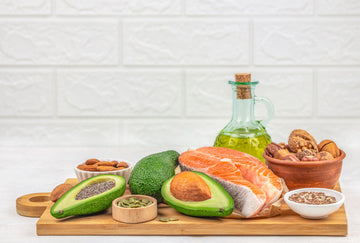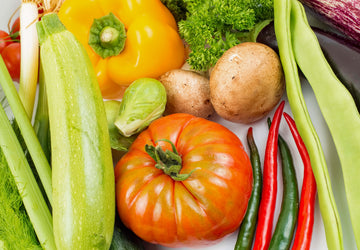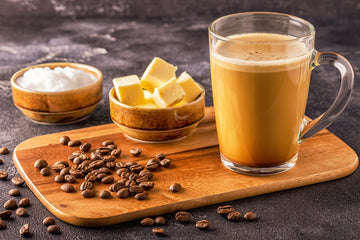The ketogenic diet requires a conscious selection of foods, as conventional flours such as wheat, spelt or rye flour do not fit into the diet plan due to their high carbohydrate content. Instead, many people turn to so-called keto flours, which are lower in carbohydrates and are ideal for baking, cooking and creative recipes. But what options are there and what should you look out for?
Flaxseed flour: The high-fiber option
Flaxseed flour is made from partially defatted flaxseeds. Its nutty flavor makes it particularly suitable for bread and savory baked goods. The texture of the flour makes it a popular choice in recipes where a firm consistency is desired. It is important to note that flaxseed flour absorbs a lot of liquid, so recipes should be adjusted accordingly to achieve the desired consistency.
Almond flour: versatile and fine
Almond flour is one of the most popular options in keto cooking. It is made from ground almonds and comes in two varieties: partially defatted almond flour and ground almonds. The partially defatted almond flour is lighter and finer, while ground almonds offer a denser consistency. Almond flour is great for desserts, cakes and cookies, but it is advisable to combine it with other flours to achieve a better consistency.
Coconut flour: Use sparingly
Coconut flour is made from dried and ground coconut meat. It is known for its ability to bind liquids, which is why it should be used sparingly. Coconut flour gives dishes a light coconut flavor and goes well with sweet recipes such as muffins, pancakes or cakes. When processing, it is important to adjust the amount of liquid in the recipe, as coconut flour can quickly lead to a dry consistency.
Lupine flour: A plant-based alternative
Lupin flour is made from the seeds of the lupin plant. It is particularly fine and versatile. Due to its neutral color, it is suitable for both sweet and savory dishes. Lupin flour is often used in bread, pasta substitutes or pancakes. Since it has a naturally stronger binding effect, eggs or additional binding agents can be reduced in some recipes.
Hemp flour: nutty and nutrient-rich
Hemp flour is made from deoiled hemp seeds and has a nutty, slightly earthy taste. It is ideal for savory recipes such as bread or pizza dough. Due to its dense texture, it is recommended to combine hemp flour with lighter types of flour such as almond or coconut flour to achieve a pleasant consistency.
Chia flour: ideal as a binding agent
Chia flour is made by grinding chia seeds and is particularly rich in fiber. It absorbs a lot of liquid and thus has a gel-like consistency that is ideal as a binding agent. Chia flour is often used in bread, muffins or as an ingredient in smoothies and desserts.
Sesame flour: mild and versatile
Sesame flour is made from deoiled sesame seeds and has a mild, nutty flavor. It is gluten-free and ideal for savory dishes such as crackers or bread. Due to its fine consistency, sesame flour can also be used excellently in combination with other keto flours.
Sunflower seed flour: The nut-free alternative
Sunflower seed flour is a great alternative to nut-based flours such as almond flour. It is made from deoiled sunflower seeds and is suitable for both sweet and savory recipes. It ensures a stable consistency, especially in bread and cakes.
Pumpkin seed flour: intense flavor and colorful
Pumpkin seed flour is slightly greenish and has an intense, nutty flavor. It is ideal for savory baked goods such as bread or rolls. Pumpkin seed flour is often combined with other flours to achieve a lighter consistency and also brings visual variety to the plate.
Hazelnut flour: aromatic and intense
Hazelnut flour is made from ground hazelnuts and adds an intense, slightly sweet flavor to baked goods. It's an ideal choice for cookies, cakes or muffins and pairs well with chocolate. Due to its high fat content, hazelnut flour should be used sparingly and combined with other keto flours to improve texture.
Walnut flour: hearty enjoyment
Walnut flour is characterized by its strong, slightly bitter taste and is particularly suitable for savory baked goods such as bread or crackers. It also goes well with spices such as cinnamon and nutmeg, which also makes it interesting for sweet recipes. As with hazelnut flour, it is advisable to mix walnut flour with lighter flours to achieve an optimal consistency.
How to combine keto flours correctly?
Keto flours differ significantly in their properties from conventional flour. They usually require more liquid or additional binding agents such as psyllium husks or eggs. A mixture of different types of flour can help to achieve the desired consistency and optimal taste.
Variety for the Keto Kitchen
From almond and coconut flour to alternatives such as hemp, chia, sesame, hazelnut and walnut flour, the keto diet offers a wide selection of low-carb flours. By consciously selecting and combining the different types, you can vary your recipes and adapt them to your personal preferences. Try, experiment and adapt is the motto here!





